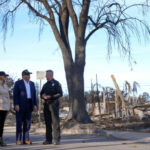A panel of industry and law enforcement officials couldn’t agree on how civilian drones should be tracked by authorities, adding uncertainty to the push for expanded commercial uses.
The advisory committee, established earlier this year by the Federal Aviation Administration, couldn’t reach consensus on key issues, such as what type of drone models should be subject to radio tracking, according to two people familiar with the deliberations. A majority of members on the committee didn’t sign on to its final report, which was submitted to the FAA last week.
The panel was split along many fronts, with hobbyists, police groups and different parts of the rapidly growing drone industry taking opposing positions, the people said. They asked not to be identified because they weren’t authorized to speak about the report, which hasn’t been released by the FAA.
The panel’s work also comes as the National Transportation Safety Board is investigating the first case of a drone colliding in mid-air with a traditional aircraft, an Army helicopter. There were no injuries and the helicopter was able to land safely, but the impact damaged one of the copter’s rotors in the Sept. 21 incident, according to a preliminary report.
The FAA panel’s breakdown is a setback for the industry, which is experiencing rapid growth but still largely prevented from flying devices over people or beyond the sight of an operator.
Finding a way to satisfy the objections of federal and local law enforcement groups, which worry that growing civilian drone operations could become a security and public safety mess, is critical to expanding operations for the unmanned industry. The FAA has said since last year it plans to release a proposal to allow drone flights over people, but the process is on hold because of objections from law enforcement agencies.
Some sort of tracking system is also critical for companies like Amazon.com Inc. and Alphabet Inc.’s X, which want to use automated drones to deliver retail goods to people’s houses. Both companies have said that all drones operating in areas with delivery flights should have to broadcast their identity and position to ensure safety.
“The FAA will review the advisory committee’s report and its findings carefully,” the agency said in an emailed statement.
The FAA and law enforcement agencies can craft regulations without the agreement of drone-industry sectors, or the FAA can ask the advisory panel to do more work. It frequently convenes such panels in an attempt to develop consensus before it begins crafting regulations.
In addition to incidents in which unauthorized drones have interfered with law enforcement and firefighters, there has been growing use of small consumer drones by overseas terrorist groups, such as the Islamic State in Syria, and agencies fear such attacks could occur domestically.
Complicating the discussions was a court decision on May 19 that struck down FAA’s requirement that civilian drone owners register with the agency. The court relied on language in a 2012 law that exempts from federal law drone hobbyists who participate in a community group.
If that court decision stands and Congress doesn’t act to rewrite the law, it may not be possible to require civilian drones to transmit their identity.
One of the benefits of requiring drone tracking is that it may allow for automatic alerts to other aircraft operating nearby.
Was this article valuable?
Here are more articles you may enjoy.

 FEMA Cancels Classes at National Fire Academy Amid Federal Funding Cuts
FEMA Cancels Classes at National Fire Academy Amid Federal Funding Cuts  China’s Auto Titans Push for AI, Flying Cars and New Plates
China’s Auto Titans Push for AI, Flying Cars and New Plates  AAA Study Shows Consuming Cannabis and Driving The Same Day is Common
AAA Study Shows Consuming Cannabis and Driving The Same Day is Common  North Sea Ship Collision Could Cost Insurers up to $100M, Hitting Marine Line Profits
North Sea Ship Collision Could Cost Insurers up to $100M, Hitting Marine Line Profits 